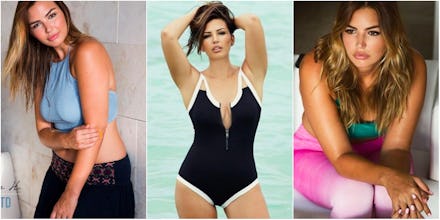This Model's Story Exposes Fashion's Problem With Women's Bodies

We may have more plus-size models than ever, but fashion still isn't OK with the true diversity of women's bodies, in all sizes.
That fact is painfully obvious from the lack of "in-between" size models, something model Katie Willcox is drawing attention to. In a new interview with People, Willcox states that she was far more successful at a size 14 than a healthy size 10.
"When I went to my agency, they were like, 'Oh, you look great!' because I was now a size 14, which is the sample size that works the most for plus-size modeling," she told People. "I started working well, but I still didn't like the way I felt. I felt really unhealthy and depressed. But I was getting rewarded for it."
"I was losing all my clients because everyone was saying, 'Oh, you're too small now, we want you fuller.'" she said in the interview. "I was shocked because I thought I looked great. I was like, why am I not valued when I look my best and I feel my best?"
Even for women above a size 2, the fashion industry is looking for a very specific kind of body — not necessarily other "regular" bodies that reflect the variety of what women actually look like.
Resistance to real body diversity: Willcox's experience isn't uncommon. The fashion industry has long maintained narrow, specific standards for models' body sizes. That applies to plus-size models as well, many of whom use padding to fit the ideal measurements brands are looking for. Model Marquita Pring drew attention to the practice back in 2011, telling Women's Wear Daily:
"Every client is different. You get a wide range. Some people like you much smaller, size 10, size 8. Some people would prefer a 14 or 16. So for me, I'm right in the middle at a sort of small 14, high 12. So I pad sometimes, since I've got clients who would prefer a solid 14 or 16."
Yes, literal foam padding, placed strategically around certain body parts like the hips. Such padding is necessary, since most fashion brands aren't looking for models at various, diverse sizes; instead, they want one standard size, ignoring models who don't fit the mold (with or without padding).
Calvin Klein model Myla DalBesio also made waves when she openly discussed to the industry's resistance to her size 10 body.
"I'm in the middle," she told Elle. "I'm not skinny enough to be with the skinny girls and I'm not large enough to be with the large girls, and I haven't been able to find my place."
The reality, of course, is that models like Pring and Willcox should be able to have — and work with — the bodies they have. They represent "real" body types just as much as size 14 or size 2 women. As DalBesio put it, "True body diversity doesn't mean only sizes 0s and 2s, then jumping to size 16 and up. There is a middle ground."
As Willcox's story demonstrates, we're not quite there yet. But as fashion takes a closer look at the women it puts in magazines and on billboards and more models speak up, we're moving towards a diversity that actually encompasses all shapes and sizes.
And that diversity matter. DalBesio wrote in Elle, "I am receiving emails from 15-year-old girls, telling me that I have given them hope and that sharing my story has made them feel less freakish, less weird, and that they can accept their size 8 or 10 frame."